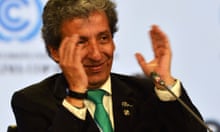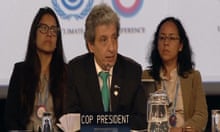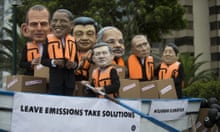Australia’s foreign minister, Julie Bishop, has just delivered a speech to the United Nations climate talks here in Lima.
On a day when more than 10,000 people took to the city’s streets calling for rapid cuts in greenhouse gas emissions, Bishop moved to defend Australia’s reputation as a “good international citizen” on climate change.
So here’s some excerpts from Bishop’s speech, annotated by me. Call it a service. Let’s dive in.
Australia has a strong track record of playing a constructive role in the global response to global climate change.
Like that time in Kyoto in 1997 when Australia managed to slip out with a target that allowed us to actually increase our emissions while, at the same time, securing a clause that would mean we would need to do almost nothing to meet it?
We take on commitments and we deliver against them. We don’t take lightly our commitments. Climate change is a challenge to us all with serious environmental, social and economic consequences.
Do these “commitments” include the massive expansion of coal and gas export projects that make Australia a world leader in fossil fuel exports? Because after all, our prime minister thinks “coal is good for humanity”. Good job these “serious environmental” consequences from climate change don’t, in the eyes of the foreign minister, include the Great Barrier Reef (even though her own scientists say it does).
Individually and collectively we must deliberate carefully and determine the best course of action to reduce emissions. This action must deliver real cuts in emissions and not put countries at a competitive disadvantage and it must work alongside countries plans for strong economic growth, jobs and development.
Just before Julie Bishop rose to speak, we heard from Leonard Balogun Koroma, the designated minister from the government of Sierra Leone. He said climate change was undermining development in Africa and getting in the way of efforts to overcome poverty. “The time to act is now,” he said. “Our survival depends on it.”
If “not surviving” could be considered a “competitive disadvantage” then Minister Bishop might be onto something.
Australia joined the first commitment period of the Kyoto protocol and we took on a legally binding target – we met it, indeed exceeded it.
Indeed we did exceed it. Our initial target was 108% – we got down to 103%. It was just so easy, thanks to the Australia clause.
Australia has an ambitious 2020 target. We will reduce emissions by five per cent based on 2000 levels by 2020. This is a significant cut – minus 19% from business as usual. Our target is comparable to those taken by other developed countries.
Yes. Our target is so “ambitious” that the government’s own Climate Change Authority says it is “not credible” and should be trebled. No wonder the government wants to axe that.
At home we have put in place policies to ensure that we deliver on our international targets. In 2001 Australia set the world’s first Mandatory Renewable Energy Target. This was expanded and extended in 2009.
It means we will generate at least 20% of our electricity from renewables in 2020.
Oh my! This from the government that appointed a climate science sceptic to review the target, has been thinking about scrapping it and is currently trying to negotiate to cut it. This is a move the renewable energy industry says will cost thousands of jobs.
Investment in large-scale renewables in Australia has already come to a standstill. This will please our treasurer, Joe Hockey, who thinks windfarms are “appalling”.
We are taking further direct action. At the heart of our direct action policy is a $2.55 billion emissions reduction fund. This fund will create opportunities and incentives for Australian business to take practical climate action. It will deliver real and measurable results for the environment while improving business competitiveness.
Here’s what else it will do. Most analysts think this new policy will fall a long way short of Australia’s “ambitious” target to cut emissions. The $2.55 billion fund is paid for by the taxpayer and is what came after Australia became the first country in the world to scrap carbon pricing laws – a victory for ideologues and the fossil fuel industry. This replaced “polluter pays” with “taxpaper pays”.
It is a comprehensive approach to climate change that benefits the environment and the community. Looking to the future, Australia will work to secure an agreement in Paris that is strong, effective and ensures countries live up to their commitments.
This “comprehensive approach” is an entirely voluntary scheme and few people beyond the offices of the cabinet ministers think it is in any way scalable if any increase in future ambition did materialise. In other words, if Australia did take the advice of its own Climate Change Authority, it would need another policy.
At the climate finance ministerial meeting yesterday, I announced Australia’s contribution of $200m over four years to the Green Climate Fund.
And what a surprise that was, especially after Tony Abbott had said he would never contribute to a scheme like that because it was ... what was the quote again … oh yes, “socialism masquerading as environmentalism”. By the way, we just stripped that $200m right out of our foreign aid budget.
Allow me to focus for a moment on research and development of new technologies.
Sure, but given my suggestion before the Lima climate talks that Australia might be defending coal while it’s here, I bet you that focus isn’t on clean energy.
Australia has a long history of driving and supporting innovative and smart climate change solutions both in Australia and other countries. Carbon Capture and Storage is a concrete example of where we have committed over $300m to low emissions coal technology research and development.
The Gorgon LNG facility in my home state of Western Australia is one of the world’s largest natural gas projects and the single largest resource development in Australia’s history. It is using best practice in emissions management including capture and storage.
Told you. While we’re talking about “supporting” CCS, is this when we mention that the government actually cut $459m from the budget of the Carbon Capture and Storage Program in the previous budget? Yes, let’s mention that.
As solar industry leader Jeremy Leggett told an earlier press conference in Lima today: “The oil and gas industry has been deploying the prospects of [CCS] as a smokescreen, knowing it will never get to industrial scale, just to buy time.”
I should also ponder if “supporting smart solutions” means also cutting millions from the budget of the government science agency tasked with innovating? An estimated one in five jobs are to go as a result.
These examples highlight the good story Australia has to tell on climate change We are taking action, we are delivering on our commitments and we are more than playing our part. This is what Australia does. That’s who we are. A reliable partner. A good international citizen.
We are such a good citizen on this climate change business, that we are currently ranked last of all industrialised countries for our performance on climate change.









Comments (…)
Sign in or create your Guardian account to join the discussion